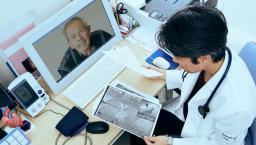How remote patient monitoring can save cancer patients' lives

Jiang Li, CEO of Vivalink
Photo: Jiang Li
Neutropenic fever is a common complication for cancer patients undergoing chemotherapy. In fact, one out of every 29 chemotherapy-treated patients is hospitalized, with a startling mortality rate of 7-9.5%. Fevers can come on suddenly and sometimes go unnoticed until it’s too late.
Remote patient monitoring devices like wearable temperature sensors offer the potential to reduce hospitalizations and deaths in vulnerable populations like chemo patients. The sensors can detect an abnormal temperature reading and flag it for the patient and oncologist to actively monitor, or in serious cases, go to the hospital for observation.
Jiang Li is CEO of wearable temperature monitor vendor Vivalink, which has been tapped for several oncology clinical trials. Healthcare IT News interviewed Li to speak to how RPM can be a game-changer for these cancer patients and their physicians, and to discuss real-world examples of the technology in action.
Q. Please talk about the neutropenia problem.
A. According to the American Society of Clinical Oncology, about half of the patients undergoing chemotherapy experience some level of neutropenia. Neutropenic fever is a common and potentially serious complication of cytotoxic chemotherapy. Patients with febrile neutropenia face a 15% higher risk of mortality compared to patients who don't experience FN.
Prior to the use of RPM technologies, the monitoring of neutropenic fever events relied on patient self-reporting and periodic manual temperature checks, which can result in erroneous reporting or delayed intervention.
As neutropenic fever sometimes occurs without symptoms or during non-waking hours, traditional spot-check methods are limited in their ability to detect episodes in a timely manner. If a neutropenic fever is not caught in real time, the infection can quickly turn into sepsis and become life-threatening.
Q. So how exactly can RPM technology help resolve, or at least decrease, the neutropenia problem?
A. The incorporation of wearable technology for fever detection has the potential to revolutionize our understanding of neutropenic fever and its related risk categories. RPM devices allow patients and study participants to simply wear a patch with a medical-grade, Bluetooth-enabled device that can continuously transmit data to secure, HIPAA-compliant remote servers in order to streamline patient care.
With the use of RPM wearables, the monitoring of patients can be automated, continuous and in real time, thereby representing a more complete and accurate picture of the patient condition. As a result, interventions can be more responsive to prevent further deterioration that can lead to readmission.
Q. Please offer a couple of examples of RPM in action to combat neutropenic fever.
A. A cancer center based in Los Angeles, California, conducted a study on 20 patients to see if the use of RPM technologies can provide advanced notice of neutropenia events that lead to hospitalization. Patients following chemotherapy were outfitted and discharged with wearable sensors that provided 24-hour continuous monitoring of key vitals.
The patient was further provided with a companion mobile device and integrated application that automatically collected the wearables data. The data is then sent over the internet to a clinician portal to be monitored remotely. Based on the trend analysis and correlation of these vitals, they were able to detect impending neutropenic events 18 hours in advance of readmission.
In another joint study, this one with UCLA Jonsson Comprehensive Cancer Center, currently underway, 80 cancer patients are undergoing outpatient intermediate-risk chemotherapy regimens and will use the wearable sensors, which will record their temperature every 10 minutes for the first three months of their regimen.
Patients with breast cancer, colon cancer, lung cancer or one of two types of non-Hodgkin’s lymphoma undergoing TC, mFOLFOX6, cisplatin/pemetrexed or R-CHOP, are enrolled. If fever is detected during one of these checks, both patients and their treating oncologist will be notified in real time, allowing for medical intervention.
Q. You've already mentioned the technology helping detect impending neutropenic events 18 hours in advance of readmission. What other kinds of results are you looking at?
A. The RPM technology implementation has yielded significant results, specifically in early detection and prevention of health complications, as shown in the study at the cancer center. By correlating multiple vitals, specifically heart rate, respiratory rate and temperature, predictions can be more accurate and can minimize false positives, as well as false negatives.
The ongoing study at UCLA has specifically targeted the incidence of neutropenic fever in patients undergoing common chemotherapy regimens. By using the automated temperature patch for remote monitoring, the study aims to facilitate early detection and treatment of neutropenic fever compared to traditional spot checks.
This timely intervention can significantly improve patient outcomes and reduce the risk of complications associated with neutropenic fever. The study is also quantifying the morbidity, mortality, healthcare utilization and costs of care among patients to further emphasize its impact on overall patient care and resource allocation.
Q. What advice would you offer healthcare provider organizations considering using RPM for such use cases?
A. When considering the implementation of RPM technology to monitor for neutropenic fever, healthcare provider organizations should carefully assess its potential and benefits. The healthcare provider organization should thoroughly evaluate the RPM technology’s accuracy and reliability.
By prioritizing patient care, healthcare provider organizations can educate patients about the benefits of RPM technology in preventing complications like neutropenic fever and can increase their willingness to participate.
Healthcare organizations should implement a robust infrastructure to support RPM technology effectively. This includes a dedicated team to oversee the program, and regular audits and quality assurance measures to identify any issues and to ensure long-term success.
The RPM system should be seamlessly integrated into the existing EHR and clinical workflows, enabling healthcare providers to access and analyze patent data efficiently. Data security measures are imperative to safeguard patient information and maintain compliance.
The success of the adoption depends on comprehensive training and education for healthcare professionals to interpret data, identify early warning signs and respond appropriately to abnormal readings. Healthcare organizations have the ability to harness the potential of RPM technology to enhance the care and safety of all patients, not just those with cancer, leading to improved patient and clinical outcomes.
Follow Bill's HIT coverage on LinkedIn: Bill Siwicki
Email him: bsiwicki@himss.org
Healthcare IT News is a HIMSS Media publication.
























